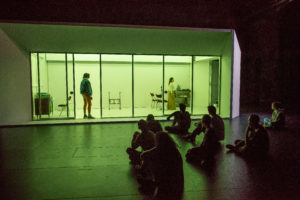Monika Zaleska: I know that you are a longtime Didion fan, and that it wasn’t easy to get the rights to adapt “The White Album” for the stage. It was also your first time adapting a literary work for the theater. How did this show come together?
Lars Jan: I’ve directed mostly things I’ve written myself, so this is the most elevated, ambitious text that I’ve ever worked with. In many ways I consider “The White Album” to be a masterpiece. It is an essay, but in many ways it feels very theatrical, like a direct address monologue. Didion herself, when she was a kid, wanted to be an actress. And she uses theater metaphors throughout the essay, the idea of “missing cues,” or feelings as though she should have a script, and also from cinema, writing about 1968 as a “cutting room experience.” She’s thinking about performativity in her writing. One of the ways we were able to get the rights to the essay was that we promised to do every word. We weren’t going to cut anything—we were going to start with the first word and end with the last.
I’d tried to get the rights for seven or eight years, sending out emails that went unanswered. Then Executive Producer of the BAM Next Wave Festival Joe Melillo said, “I’d really love you to do something here, what would you like to do?” I’d never really been asked that question before—it was a career highlight. I said, “The White Album.” So they got the ball rolling, getting me in touch with Joan Didion’s agent. But we couldn’t get a green light. It wasn’t until Mia reached out to Didion’s nephew, Griffin Dunne, who with faith in the idea expressed to him, went over Joan’s apartment later that afternoon. Then we got a call from her representatives, who sounded pretty surprised as they said, “You’re never going to believe this, but you have the green light.”
MZ: As an essay, “The White Album” is made up of cutting room snippets, as you mentioned, and it presents many disparate scenes and moments from 1968. In your show, there’s a bare stage with this stark Californian house, designed by P-A-T-T-E-R-N-S architectural firm from Los Angeles, as the centerpiece of the action. How did you make a cohesive show out of such an anecdotal and far-reaching piece of writing?
LJ: One of the brilliant aspects of the essay is its collage form—collage and montage and various types of simultaneous layering or unexpected, arrhythmic juxtaposition. If there is a central location in the essay, I’d say it’s her house on Franklin Avenue, which is a few miles from where I live in Hollywood. But on stage the house takes on many different characteristics: it becomes The Doors recording studio, a courthouse, and then the location of a contemporary house party. I’m really responding to Didion’s idea of the “shifting phantasmagoria that is our actual experience.” So it’s a nonlinear, almost magical, at-times-impossible landscape. I used that idea as a lens through which to build the work.
 A scene from “The White Album” by Joan Didion created by Lars Jan.
A scene from “The White Album” by Joan Didion created by Lars Jan.MZ: You have one actor, Mia Barron, essentially performing the entire essay as a monologue with other actors stepping into to play certain supporting roles. She’s also listed as a co-creator on the program. Could you tell me how you worked together to create this piece?
LJ: Mia is my partner, so we’re collaborators in life, but this is our first artistic collaboration. I knew it was going to take a lot of skill with language to inhabit someone as complex as Didion and make the larger experience work. In our show there’s one person delivering ninety-five percent of the language. You have to be able to stick with them for an hour and a half. Mia is an actress unquestionably capable of that. I knew this was a perfect marriage of her brain and Didion’s, her talents and Didion’s talents. To get started, we did a first family residency at Headlands Center for the Arts and brought our daughter with us. One of the goals of the project was to see if we could continue to have fulfilling artistic lives but also see each other consistently and have our child involved. There’s also a lot of work that Mia did on her own with the text and I did with other collaborators. Throughout the development process we started putting the pieces together and we’d have conversations, in and out of rehearsal, about how that was working. ... [mehr] https://lithub.com/how-joan-didions-the-white-album-made-it-to-the-stage/
Keine Kommentare:
Kommentar veröffentlichen